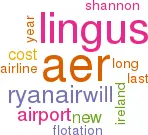Aer Lingus floats
September 2006


After about ten years of indecision and procrastination the Irish government will privatise Aer Lingus at the beginning of October. Shares will be priced around €2.35, which would value the airline at around €775m, about €470m of which will accrue to the airline itself. The state will retain at least 25% of the company and a further 15% has been allocated to an employee stock ownership trust (ESOT). Initial indications are of strong demand for the stock from institutional investors, though retail demand is likely to be curtailed by the minimum purchase requirement of €10,000.
The flotation appears to have been priced to ensure a smooth take–off. As at the end of last year Aer Lingus had a book value of €403m and cash totalling €529m. More importantly, it has an impressive profit record — €100m pre–tax in 2005, a margin of 8.7%, and €125m in 2004 (before an exceptional cost for restructuring of €102m).
The first half of 2006 did, however, show the impact of mainly high fuel prices — a drop in profitability to €3.6m from €45.6m in the same period of last year. Intriguingly, the prospectus restates the 2006 numbers to an "underlying" profitability of €16m that is slightly up on restated 2005. The underlying results reflect the various effects of new accountancy rules relating to the treatment of derivative costs for fuel, interest rate and currency hedging (rules which are too complicated to explain in a short, or indeed a long article).
Aer Lingus seems to be an attractive proposition. Under the previous management team led by Willie Walsh, the airline defied the post–September 11 depression, and reinvented itself as a flag–carrier operating on easyJet principles — internet distribution, dynamic yield management, cost cutting in all areas while expanding, A320 fleet harmonisation — though retaining some key service guarantees like never stranding a passenger and frills like seat allocation.
Walsh’s successor as Aer Lingus CEO — Dermot Mannion — comes from Emirates, the highly successful, low–cost long–haul carrier. Combine the experience and expertise of the short and the long, and the result should be a very formidable operation — although the Emirates analogy is somewhat inaccurate as Aer Lingus’s Atlantic network is point–to–point rather than hub based, and so is closer to the Virgin Atlantic model.
Inevitably, there are a series of strategic questions:
- Can Aer Lingus retain its cost competitiveness? Whereas the Walsh regime wanted to push ahead with another round of labour redundancies, a collective pay increase (of about 4%) was agreed in the summer in order to secure union and political support for the privatisation. In addition, Aer Lingus has committed €104m of the flotation proceeds to topping up the pension fund. The ESOT is supposed to align the interests of the employees with the shareholders, but the effectiveness of such schemes at traditional airlines has been very poor.
- Is Ryanair going to be aggressive? Sharing a base airport with Ryanair has been an instructive experience for Aer Lingus, but Ryanair until recently hasn’t been growing from Dublin, because of its objection to the airport charges. But this year it has launched a series of new routes including Madrid, Berlin, Venice, Valencia and Salzburg which compete with Aer Lingus, while Aer Lingus has launched to Newcastle, a Ryanair city. Direct competition has been mitigated by airport strategy, with Aer Lingus always flying to the primary airport and Ryanair usually to the secondary, but there are now overlaps — for instance, Aer Lingus and Ryanair both operate to Berlin Schoenfeld, and Ryanair has announced that it will be flying into Madrid Barajas rather than low cost Don Quixote airport, so upsetting the $1.
- What are the prospects for profitable longhaul expansion? Aer Lingus’s focus for growth is now on long haul, with most of the flotation proceeds allocated to A330 fleet expansion. Last November, Ireland and the US signed a transitional agreement that changes the Shannon stopover rule from the current one in two transatlantic flights from Dublin to one in three and grants Ireland three additional cities in the US (Aer Lingus currently serves New York JFK, Boston, Chicago and Los Angeles). This agreement is intended to be a transitional measure before the implementation of a full EU/US Open Skies treaty, but it is not totally clear whether the proposal would contravene the EU’s policy on individual member states not negotiating their own liberalised bilaterals with the US.
It is also not certain that additional US cities (San Francisco, Miami and Washington?) will be able to generate enough point–to–point, higher yielding traffic to make the new routes profitable, and reducing the Shannon stop requirement potentially increases US carrier competition into Ireland. In the old days Aer Lingus would have been grateful for the protection offered by the Shannon policy; these days, it expects Europe’s most buoyant economy to be able to generate the required business and leisure volumes.
| Jan-June | ||||
| 2004 | 2005 | 2005 | 2006 | |
| Revenue | 1,009.6 | 1,002.6 | 451.6 | 508.3 |
| Operating Profit | 122.5 | 89.9 | 46.0 | -8.2 |
| Exceptional Item | -102.5 | 4.3 | ||
| Net interest (income) | -7.3 | -10.2 | -5.0 | -9.2 |
| Pre Tax | 27.3 | 100.1 | 51.0 | 5.3 |
| Taxes | 4.4 | 11.1 | 5.4 | 1.7 |
| Net result | 22.9 | 89.0 | 45.6 | 3.6 |